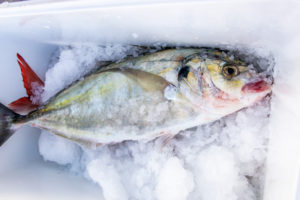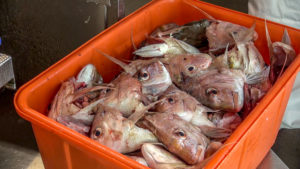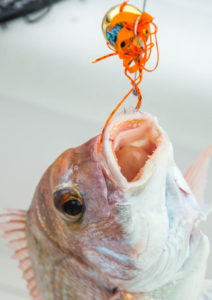Minimising your impact on other sea creatures – Part 3
Learn the rules around how to operate around cetaceans and pinnipeds.

Learn the rules around how to operate around cetaceans and pinnipeds.
Part 1 – Minimising your impact on the ocean – the problem with plastic in the marine environment

Emma Cronin, conservation consultant, discusses how to avoid seabirds when out fishing.
Part 1 – Minimising your impact on the ocean – the problem with plastic in the marine environment

Camden Howitt from Sustainable Coastlines talks about the issues around plastic that faces our marine environment and what we can do about it.

Scott Macindoe shows us how to utilise the parts that aren’t the fillets – heads, frames and organs.

Scott Macindoe teaches a different way of filleting which utilises more of the fish than traditional filleting techniques.

Mandy Kupenga discusses iki and icing techniques to help keep your catch in the best condition.

The best way to minimise waste eg harming or killing undersized fish is to employ methods that help target the fish you want to catch. Using circle hooks and removing your barbs are just two ways to do this. Her is part two of our video series.

The best way to minimise wasting your catch, eg harming or killing undersized fish, is to employ techniques that help target the fish you want to catch. Here is part one of the video on which techniques to use.


With springtime fishing underway, heads and frames have been seen washing ashore at Takapuna beach recently. They had obviously been discarded not far away after a day’s fishing at or around the boat ramp.
What is unfortunate is that the amount of sweet tasting flesh on the head and frame of fish like snapper is significant. The meat next to the bone and skin has the best flavour and so much is left behind when just the fillets are used and the rest tossed over the side.
The great news is that there is a movement afoot to help people share the unwanted heads and frames of their catch with people eager to get their hands on those same heads and frames. Matt Watson started the website www.freefishheads.co.nz to make it real easy to connect these two groups of people and ultimately, utilise the whole fish so nothing is wasted.
Fresh and tasty protein is getting more and more expensive and the shop bought stuff will not be the same as something pulled out of a chilly bin from being caught a few hours earlier.

The Kai Ika project is an initiative in the same spirit, where the Papatuanuku Kokiri Marae collects these fish parts from the Outboard Boating Club (with plans exciting plans for Westhaven Marina on the cards to be joining the project). A fish processing building with benches, hose and chilling facilities means fishers can take their prized fillets home and give away their other parts, which are equally precious to the community connected to the Papatuanuku Marae. This initiative has recently been selected as a finalist in the NZI Sustainable Business Awards – Transforming Food Category.
All it takes is a little effort (it could be simple as phoning people from the free fish heads website while on the water) and someone gets the heads and frames when you arrive at the ramp. If you fillet your fish later, you could meet at a local location with a chilly bin and some ice and complete the collection that way.
Making the effort to share something of value does immense good for our community as a whole, the individuals in that community, our environment and of course we ourselves get a bit of self-respect knowing we’ve done the right thing. In the same spirit of caring and sharing, LegaSea has been working with Matt Watson with his Free Fish Head initiative to help fishers best utilise what they catch see www.freefishheads.co.nz for more information.


What is barotrauma? Barotrauma usually refers to injury caused by a change in pressure when fish are retrieved from depths of 20 meters or more to the surface.
Some species like kingfish and kahawai are more resilient when being pulled from depths of 30 meters or more. The popular snapper however starts to succumb to the change in pressure and although they are effected by barotrauma, there are ways to minimise the effects and give them a good chance at survival.
Firstly, if you catch a legal sized fish from any depth, keep it and then stop fishing once you have caught your limit or caught the number of fish you need for the day.
There has been a popular misconception that slowly retrieving a fish from depth will eliminate barotrauma. The time it takes fish to depressurise is closer to hours and not minutes, so it is a better strategy to quickly pull the fish up and then release it quickly and carefully so it has more energy to get back down to a comfortable depth.
 The fastest way to return a fish back to the depth it came from is with a descender rig. There are commercial versions in Australia but a home-made job is very easy to whip up. Simply drill holes in the top and bottom handles of a pair of plastic fish grips, add a puka bomb (16oz or heavier) via a 30cm section of heavy mono to the lower handle and tie your line to the upper handle. The grips are carefully attached to the lower jaw of the fish and then gently lowered into the water. The rig descends to the bottom and a quick jerk on the line releases the fish.
The fastest way to return a fish back to the depth it came from is with a descender rig. There are commercial versions in Australia but a home-made job is very easy to whip up. Simply drill holes in the top and bottom handles of a pair of plastic fish grips, add a puka bomb (16oz or heavier) via a 30cm section of heavy mono to the lower handle and tie your line to the upper handle. The grips are carefully attached to the lower jaw of the fish and then gently lowered into the water. The rig descends to the bottom and a quick jerk on the line releases the fish.
If you don’t have a descender rig, puncturing the buccal cavity that is protruding from the mouth is an acceptable approach and a study in Australia showed reasonable survival rates. Using the tip of a hook or similar small sharp clean object is the way to do this.
Remember, every second counts as the longer a fish is out of the water, suffering from barotrauma, the less its chances of survival when returned. Takes photos quickly (have the camera all ready to go) and handle the fish as little as possible before release.
For more details on handling and release techniques go to www.fishcare.co.nz/handling-and-releasing
Photo credits: Digital Fish
